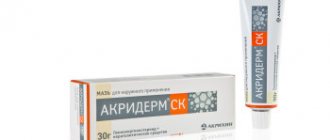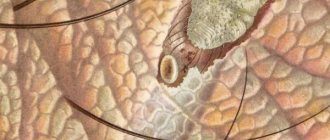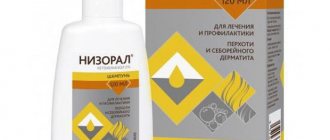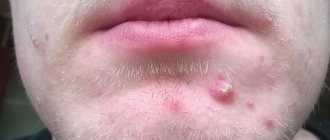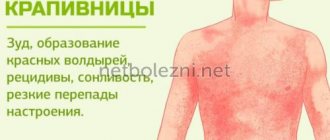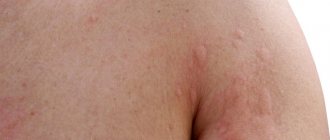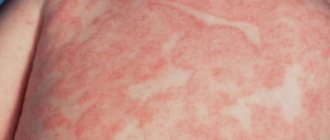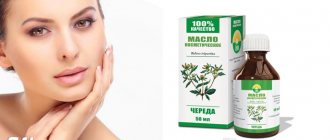Contraindications
The most effective drugs for urticaria - glucocorticosteroids - have the widest list of contraindications.
These are severe damage to the liver, kidneys, gastrointestinal tract, pregnancy and lactation. Antihistamines and anti-anxiety tablets may cause drowsiness. Therefore, during the treatment period, you should avoid driving vehicles and performing work that requires concentration and attention. If during periods of remission it is enough to rub in ointments and gels, then during relapses tablets are used. Therapeutic regimens include drugs for urticaria to eliminate allergic agents, relieve symptoms, and prevent the spread of inflammation to healthy areas of the skin and mucous membranes. All of them are very effective, and if the dosage regimen is followed, they are safe.
Ointments for treating children
Ointments for urticaria for children should be safe; preference should be given to non-hormonal agents:
- A good ointment is Gistan (Gistan N is a hormonal drug). The product has a natural composition: calendula, string and birch buds have a calming and anti-inflammatory effect.
- If hives appear on your child's face, you can use safe Nezulin cream. It copes with redness, rash, itching and burning. The cream contains D-panthenol, celandine, plantain, chamomile, licorice and essential oils. From 1 month of life, Zinocap and Zinc ointment are also allowed.
- For children from 1 year old, Skin-Cap cream can be used. If prescribed by a doctor, it can be used from 6 months. This is a zinc based product. The effect of the drug is drying, anti-inflammatory, antifungal and antibacterial. The cream helps restore skin.
- La Cree is a powerful moisturizing and nourishing agent, but it does not eliminate the allergic reaction, but only improves the condition of the skin. This cream should be used if your skin is too sensitive and dry, preferably together with antihistamine gels.
- Fenistil, which is approved for babies from 1 month of life, is also suitable.
When applying Fenistil gel to large areas of the skin, you need to monitor the child to avoid unwanted reactions.
Among the hormonal drugs it is worth noting:
- Elokom. Allowed from the age of 2 years.
- Soderm. Suitable for children from 1 year.
- Gistan N. Allowed from 2 years.
- Sinaflan. Can be used from 2 years of age.
- Prednisolone or Hydrocortisone. Allowed from 1 year.
Hormonal ointments should not be taken for longer than 5 days. The regimen and duration of treatment should be determined by the doctor.
Local remedies for urticaria should be used simultaneously with systemic medications. The therapeutic effect in this case will be most pronounced.
Author: Oksana Belokur, doctor, especially for Dermatologiya.pro
Diet features
Against the background of the drugs used for urticaria in adults, it is necessary to follow a diet. During the treatment period, it is better to exclude foods that can cause allergies.
Excludes:
- Chocolate;
- Coffee;
- Chicken;
- Eggs;
- Canned foods;
- Smoked food;
- Alcohol.
There are a number of foods that can cause allergies due to the release of histamine. Histamine triggers an allergic reaction in the body. The products are histamine liberators and therefore must be excluded from the diet too.
Histamine liberators include:
- Citrus;
- Sauerkraut;
- Cheese;
- Industrial sausages.
If you are intolerant to aspirin, it is recommended to exclude raspberries, bananas, and apricots from your diet. It is necessary to observe the recommended restrictions in the consumption of products for at least 4-5 days, even if skin changes in adults have disappeared after taking medications for urticaria.
It is necessary to stick to foods that have a low allergic effect in your diet. Nutrition should be balanced and correspond to mental and physical stress
And it is also important to take vitamins for hives. It is advisable to use multivitamin formulations.
Toxin-removing drugs for urticaria
Blisters on the epidermis occur due to problems with the liver or pancreas. Malfunction most often occurs due to the accumulation of toxins in the body.
For this reason, for the treatment of urticaria in adults, medications are prescribed that relieve the body of harmful substances. Such products are called sorbents.
Most often, patients take white or black activated carbon. These products quickly remove toxins and are affordable. This explains the popularity of such products.
Experts often prescribe drugs such as Filtrum, Polysorb, Gastrosorb, Enterosgel and other similar products.
Sorbents relieve skin itching, blisters, redness and swelling of soft tissues.
Drug release form
Antihistamines come in almost all drug forms. Anti-allergy tablets, dragees, powders for preparing suspensions and even delicious syrups are widely available on the market. Parents like the latter, because sometimes getting a child to take medications turns out to be a difficult and quite nerve-wracking task.
In acute conditions, drugs are prescribed in the form of injection solutions or intravenous infusions. This is due not only to the fact that active antihistamines begin to work faster, penetrating directly into the blood. If the patient is unconscious, swallowing the medicine independently is simply impossible.
In cases where the allergic reaction inhibits the respiratory tract, nasal sprays may be recommended. They quickly eliminate swelling, making breathing easier, and help cope with a runny nose. These medications are especially popular during peak months for seasonal allergies, such as to pollen from certain flowers. They also help patients suffering from hypersensitivity to dust, cat and dog hair.
If the allergy manifests itself in the form of skin symptoms, ointments and creams with a strong antipruritic and decongestant effect can be prescribed. The advantage of this form of antihistamine is the locality of its action and the rapid onset of a state of relief.
Antihistamine drops will relieve unpleasant symptoms affecting the eyes:
- lacrimation;
- itching;
- foreign body sensation;
- manifestations of conjunctivitis.
First aid for acute manifestations of urticaria
Antihistamines do not always give the desired effect for urticaria. If such medications do not help, this leads to anaphylactic shock and Quincke's edema. These are dangerous conditions that, without proper treatment, cause death in the patient. Their occurrence is accompanied by the following symptoms:
- swelling of the larynx, causing suffocation;
- a sharp drop in blood pressure;
- loss of consciousness.
If such symptoms are detected, you must immediately call an ambulance. Before the arrival of specialists, it is recommended to perform the following manipulations:
- place the patient on his back so that oxygen can enter the lungs;
- place a cushion under your feet to reduce blood pressure;
- administer intramuscular medication.
Injections for urticaria give an almost immediate effect. As a rule, a person suffering from this pathology always has a syringe with medicine in case of an attack. For acute pathology, the following traditional medicine products are recommended:
- Adrenalin. This remedy quickly relieves any attack caused by an allergy, including anaphylactic shock. The drug is injected into the muscle using a syringe. If there is no visible result, the injection is repeated after 10 minutes. Dosage – 1 ml of 5% solution;
- Prednisolone. This product has anti-shock and anti-allergic properties. In acute conditions, the drug is injected into the muscle every 4 hours. Dosage – up to 120 ml of the drug;
- Diphenhydramine. This remedy has an antihistamine and hypnotic effect. Dosage – 2 ml of 1% solution. This portion is recommended to be injected into the muscle every 4-6 hours.
After administering the drug, the patient can wait for the ambulance to arrive without fear for his life.
Diet during treatment
Since urticaria in most cases is still an allergic disease, following a diet in order to achieve a speedy recovery is necessary. Many people are interested in the question of what diet they should adhere to.
In this case, the answer cannot be unambiguous, since everything depends on the patient’s preferences and the factor that provoked the process of the appearance of urticaria.
But the average formula still exists, and it is presented below:
- completely eliminate alcohol;
- stop smoking (at least until severe symptoms subside);
- do not eat citrus products (oranges, lemons, tangerines, pineapple);
- completely exclude from consumption the product that caused the allergic reaction.
When a person does not know what irritating factor caused hives, it makes sense to go on a diet.
Products whose consumption is not prohibited are presented below:
- milk and lactic acid products (cottage cheese, low-fat cheese, low-fat yogurt without dyes and preservatives, fermented baked milk, kefir);
- non-fatty steamed fish;
- boiled turkey, chicken or beef;
- vegetables boiled or baked in the oven;
- eggs;
- buckwheat, oatmeal, pearl barley porridge, prepared without adding oil.
Dietary nutrition should be observed throughout the entire period of treatment, as well as for 14 calendar days after the disappearance of the main symptoms of the disease. By the way, if the allergic reaction was compromised by a food product, then it should be avoided in the future.
What are the forms of the disease and how to treat them
Before starting treatment, you need to determine the form of the disease.
- Solar form. The result of the action of ultraviolet rays on the skin. It manifests itself as redness of the skin, blisters, swelling, accompanied by itching and peeling. Antiallergic and antihistamine drugs are prescribed as therapeutic measures, and protection from exposure to sunlight is recommended.
- Cholinergic type. Hives occur after a hot shower, exercise, or stress. Treatment of this form of urticaria is mandatory, but it is necessary, if possible, to avoid the factors that provoke it.
- Acute form. It appears suddenly and is characterized by dense rashes on the body, consisting of pink or red blisters. The areas of the skin affected by the rash are accompanied by severe itching. Treatment of the acute form consists of immediately taking an antihistamine; in case of complications, hormone therapy is prescribed (treatment is prescribed by a doctor).
- Allergic form. Characterized by rashes and severe itching, although not always. Treatment of this form consists of eliminating foods or cosmetics that provoke allergies from the diet, followed by medical therapy.
- Recurrent form. Urticaria is characterized by long-term (more than six weeks) rashes on the body, which over time can change location. Histaglobulin is used for treatment.
How to choose a remedy for urticaria
Acute or chronic form requires timely use of medications, and an integrated approach is important here. The chances of recovery are high only if the drugs are selected correctly. We have compiled not only a review of reliable and proven products, but also recommend relying on several criteria - doctor’s consultation, composition, contraindications and side effects, effectiveness and reviews.
Specialist consultation
Any disease requires examination in a clinical setting, making a correct diagnosis and determining the causes. A rash on the arms, legs, face or body is treated either by a dermatologist or an allergist; only such a specialist knows how to cure urticaria in adults forever. Self-medication at home is fraught with complications. It is especially dangerous for children, pregnant and breastfeeding women.
Compound
Another important parameter by which a medicine is selected is the active ingredients in the composition. To suppress skin inflammation, components with sedative, antihistamine, anti-inflammatory, and adsorbent effects are used. There are synthetic, hormonal, and herbal medicines. The first two options help faster, are appropriate for severe forms, but have contraindications and risks of side effects. The natural formula works softer, slower, but is safe and allowed for everyone.
Contraindications and side effects
Any medicine in the instructions prescribes contraindications and side effects. Most often, serious pathologies of the digestive system and individual intolerance may be limitations to treatment. Against this background, dyspepsia and allergic reactions may occur.
Before purchasing, be sure to pay attention to age restrictions, recommendations for pregnancy and lactation
Photo of hives
In the pictures below you can see how urticaria clearly looks.
Urticaria is a pathology that goes away quickly with timely treatment. However, incorrectly selected medications or lack of qualified treatment can lead to anaphylactic shock or Quincke's edema. To prevent this from happening, at the first symptoms of the disease you need to visit a doctor and not self-medicate.
What is the best remedy for hives?
As soon as the first signs of urticaria appear on the skin, you need to select medications to combat it. Follow doctor's orders. The expert rating compiled by the Vyborexperta.ru project is aimed at narrowing the search range in pharmacies. Comparative analysis showed:
- Suprastin is the first aid for suppressing allergies without side effects;
- Advantan is a highly safe hormonal ointment against complex forms of the disease;
- Polysorb is a fast-acting enterosorbent for adults, children, and pregnant women;
- Persen Forte is a herbal sedative to eliminate nervousness as a cause of urticaria.
The presented review of effective remedies for rashes in adults and children is not unconditional; the final word belongs to the doctor. Where to buy them, which pharmaceutical manufacturer to give preference to is a purely individual decision.
What is urticaria?
Urticaria is a polyetiological skin disease and manifests itself in the form of urticarial rashes (in other words, blisters form on the skin). The pathology may also be accompanied by angioedema. Urticaria ranks honorably third among allergic manifestations in terms of prevalence. In second place is bronchial asthma, and in first place is an allergic reaction to medications.
The peculiarity of urticaria lies in its manifestation: the patient develops characteristic rashes on the skin that are a little reminiscent of nettle burns. In some cases, this can be accompanied by very severe itching, so much so that patients may experience nervous breakdowns.
According to statistics, urticaria is quite common in medical practice. More than 20 percent of the world's population will experience this disease during their lifetime. It is worth noting that the acute form of the disease affects the human body much more often than the chronic form. In the first case it is about 70 percent, and in the second - 30 percent.
To effectively combat urticaria, it is necessary to carefully study this disease, the causes of its development and characteristic symptoms. It’s not for nothing that people say: “Forewarned is forearmed.”
Diagnosis of urticaria
First of all, the doctor asks questions about the manifestations of the disease and examines the patient’s body:
- The specialist finds out the possible causes of the rashes, the frequency of their occurrence, localization features, prevalence and duration (this helps determine which medicine for hives will be most effective).
- The severity of manifestations and characteristics of formations (shade, presence of edema, shape and size) are examined.
- The patient is asked about the presence of urticaria in close relatives and chronic diseases.
If an allergic type of pathology is suspected, an allergological examination is prescribed. Specialists perform samples with potential allergens.
Provocative tests may be performed. For example, applying ice to the skin if cold urticaria is suspected, prick testing (prick testing), patch testing and intradermal tests.
If the allergic nature of the pathology is confirmed, further diagnosis is not required. You can immediately proceed to treatment.
Otherwise, urticaria is secondary in nature and occurs against the background of another pathology. With such urticaria, drug treatment will be completely different. And the examination of the patient will be more comprehensive.
- general blood test;
- biochemical analysis of blood composition;;
- general analysis of urinary composition;
- analysis for hepatitis B- and C-types;
- analysis for the presence of syphilis;
- blood examination for the amount of immunoglobulin E (IgE);
- examination for the presence of parasites in the body;
- Ultrasound and x-ray of organs;
- Gastroscopy (FGDS);
- electrocardiogram (ECG).
When examining the blood composition, urticaria is indicated by an increase in ESR and leukocyte volume, coupled with a decrease in the number of red blood cells. For hives, medications for treatment may depend on these factors.
How does urticaria manifest?
The main sign of the pathology is the appearance of itchy rashes in the form of blisters on the epidermis, like after a nettle burn. In this case, redness of the skin around the formation is observed.
The rashes have an irregular shape and are also characterized by the absence of clear boundaries. Blisters most often occur in groups. The rashes tend to merge, so they often combine into one large formation.
A distinctive feature of the blisters that appear with urticaria is their rapid and complete disappearance. Within a short time, with proper therapy, the rashes change tone to a pale shade and disappear.
In this case, no traces in the form of scars or burns remain on the epidermis. This is the exact opposite of a burn. In this case, the blisters can remain on the body for a long time, and after disappearing, scars remain that disappear only after a certain period of time.
Another characteristic feature of blisters in urticaria is that some time after the rash disappears, the rash appears again. In this case, formations appear in a completely different place from where they were initially observed.
For example, if blisters appeared on the upper extremities and then disappeared, then the rash may appear on the lower extremities and after some time, also disappear and form in another place.
The doctor selects a remedy for urticaria based on the subjective characteristics of the patient and the nature of the pathology. Self-therapy can aggravate the situation and cause complications.
Carrying out treatment
How to quickly recover using a complex of drugs to treat urticaria? When the first symptoms of the disease appear, treatment must be started immediately. There are various drugs for the treatment of urticaria.
1st generation products
These drugs will help to cure effectively. However, the observed results in treatment do not last long. When taken for a long time, the observed effectiveness decreases. And so the elements begin to pour in again. Therefore, the course of treatment is carried out for 2 weeks, followed by replacement. The drugs also have disadvantages: they can cause drowsiness, having a sedative effect; cannot be used by a group of people whose activities require increased concentration of attention. Among the observed side effects: increased heart rate, constipation, visual disturbances, dry mucous membranes and other phenomena.
The following drugs are mainly used for urticaria:
- Suprastin: for home use, adults are prescribed 1 tablet (25 mg) 3-4 times a day. Suprastin should be taken with enough water during meals. Suprastin for urticaria has a hypnotic effect, a change in heart rate towards acceleration or reduction, dyspeptic symptoms from the gastrointestinal tract;
- Diazolin: the effect of sedation is insignificant. Dyspeptic symptoms from the digestive system are noted. The effect on the nervous system is minimal. The drug can slow down reactions and disrupt the processes of the body’s excretory system. The toxicity of the drug is also noted.
2nd generation products
These medications for urticaria have a less pronounced sedative effect. There are fewer side effects: they do not cause drowsiness or disruption of the nervous system. The drugs can be used for allergic conditions and to relieve itchy skin.
The main remedy for urticaria, 2nd generation: fenistil. Fenistil helps well with allergic diseases, noting skin itching of various etiologies, and preventing allergic manifestations when performing hyposensitizing therapy. It is recommended to take 20-40 drops 3 times a day.
3rd generation products
The drugs actively affect metabolic processes. There are a minimum of adverse reactions. Most people prefer to take this group of drugs. The most in demand: Zyrtec, Cetrin, Telfast. There is no toxicity to the heart. Often prescribed for allergies and bronchial asthma. They are effective in treating various skin diseases.
4th generation products
One of the latest pharmaceutical developments, which allows eliminating allergic consequences, has a minimal number of side effects. The drug quickly begins to act and retains its effect for a long time. No harm to the cardiovascular system is noted. Contraindications for such drugs include pregnancy and childhood. Before use, it is advisable to consult with your doctor.
They are mainly used: levocetirizine, Erius, fenspiride, cetirizine. The direction of the drug cetirizine is noted for allergies. This manifests itself in blocking histamine H1 receptors. The drug must be used in the recommended dosage. Antiexudative and antipruritic effects are noted in urticaria. The drug cetirizine can have an effect both at the initial stage of allergies and at the final stage. Actively affects the pathology of the bronchopulmonary system, especially asthma. The drug cetirizine begins to act within 1 hour after use.
Cetirizine is available in the following dosage forms: tablets, syrup, drops. The course of treatment depends on the season of the year. If urticaria appears depending on the weather, then use is carried out for 3-6 weeks. In case of another cause of the disease, 1 week of treatment is sufficient to treat the disease.
Drug recommendations
From the group of non-steroidal anti-inflammatory drugs, which drugs are still better? Undoubtedly, there is a better therapeutic effect when using 4th generation drugs. There is a pronounced effect in terms of treatment, with minimal side effects on the cardiovascular, nervous and other systems. The effect of exposure is noted both at the beginning of the allergic course and during the process and lasts until the last symptoms subside.
First aid medications
If symptoms of urticaria suddenly appear, you should immediately contact a specialist who will prescribe medications that quickly relieve itching and accompanying symptoms.
The most commonly used medications are:
- Dexamethasone – a hormonal drug prescribed in the form of a solution for intramuscular administration. For acute urticaria with severe itching, the patient is administered from 1 to 4 ampoules, depending on the area of skin damage and body weight.
- Hydrocortisone ointment is another hormonal drug that is applied topically to relieve itching and rashes. Immediately after use, patients note a decrease in symptoms. Apply the product in a thin layer to the affected areas, repeat the procedure 2-3 times a day.
- Suprastin is a popular antihistamine, which is also administered intramuscularly in 1-2 ml doses, depending on the severity of the manifestations. Typically, experts insist on administering the medication before bedtime.
- Furosemide is a loop diuretic that stimulates glomerular filtration in the kidneys. At the same time, the amount of urine increases, blood pressure decreases, and the symptoms of urticaria are weakened. In the morning or afternoon, the patient is administered 2 ml of solution intramuscularly.
Such medications are used on the first day of treatment to eliminate acute symptoms. Sometimes the course lasts 3 days, which helps prevent complications. After this, the doctor prescribes other medications.
Antihistamines
Therapeutic products are aimed at eliminating free histamine and removing it from the body. It is this substance that is negatively perceived by the immune system, causing a rash and itching.
When treating urticaria in adults at home, a variety of medications are used. There are several types of medications, each with pros and cons. Doctors prescribe pills for hives on the skin and various remedies to help overcome this disease.
3rd generation drugs
The best new generation remedies for urticaria do not have a sedative effect and are approved for people whose activities involve increased concentration.
The medications block H1 receptors, cope with allergic manifestations, and have no side effects on the heart. The group includes:
Erius. Available in the form of pills and syrup, the drug acts quickly and effectively copes with the manifestations of urticaria. It is forbidden to use during pregnancy, lactation, and should not be used by children.
Use with caution if you have renal impairment. Price – 30 rubles. Gismanal
The effect develops throughout the day, the peak of action is reached after 8–9 hours. The drug does not enhance the effects of alcohol and does not in any way affect the ability to drive a car. The drug may cause increased appetite, drowsiness, tachycardia, dry mucous membranes and other side effects. Price – up to 1 thousand rubles.
2nd generation drugs
These drugs do not affect the central nervous system, do not affect human reactions in any way, act for 24 hours, a single dose per day is recommended. The medications are not addictive, the therapeutic effect lasts about a week after completion of use. It is prohibited to use medicinal products for diseases of the liver, kidneys, and cardiovascular system.
This group includes:
- Cetrin. The drug copes with its task perfectly; taking it in courses helps prevent the occurrence of new allergic reactions. The product is available in different forms and is easy to use. An overdose can lead to constipation, sleep disturbances, and increased anxiety. Price – 250 rubles.
- Clarisens. The drug suppresses the production of histamine, even copes with Quincke's edema, and quickly alleviates the patient's condition. The effect lasts for a day and is not addictive. Individual intolerance to individual components often occurs. The average cost is 60 rubles.
1st generation drugs
They give a quick and strong, but short-term effect; long-term use of the drugs reduces their effectiveness; medications must be changed every two weeks. Disadvantages of this group: they have a sedative effect, it is prohibited to take them to people who are engaged in activities that require increased concentration.
Taking first-generation medications can cause tachycardia, disturbances in stool, vision, dry mucous membranes and a host of other side effects.
An impressive list of negative reactions of the body makes first-generation drugs not very popular, but they are still used to treat urticaria. This group includes the following funds:
- Diazolin. It has a mild sedative effect and is actively used in cases where it is not desirable to influence the central nervous system. It can slow down human reactions, causes gastrointestinal and bladder problems, there is information about the toxicity of the drug. The average cost of one package is 65 rubles.
- Fenkarol. Used in extreme cases during the body's adaptation to other antihistamines. It is able to reduce the level of histamine in tissues, blocks H1 receptors, and does not have a pronounced negative effect on the central nervous system. Disadvantages: it is prohibited to use for diseases of the gastrointestinal tract, cardiovascular system, it has a weak effect. Cost – 250 rubles per pack of 20 pcs.
How to treat urticaria in adults at home
People who are interested in how to cure hives at home need to know an important thing. Hives are a symptom that occurs if an adult or child has an allergy or hypersensitivity to various substances. With the help of antihistamines, ointments, herbal medicines, and home remedies, you can stop an attack, relieve itching and reduce rashes. But urticaria needs constant monitoring and prevention.
Before using any remedy, even a safe one, you must notify your doctor.
In addition to medications prescribed by a doctor, homemade medications can be used to treat urticaria:
- herbal infusions, decoctions, teas;
- tinctures with alcohol or vodka;
- natural ointments and creams of our own making;
- various compresses, baths with extracts, decoctions of medicinal herbs.
Herbal infusions and decoctions
Treatment of urticaria at home in adults is carried out using medicinal infusions and decoctions from plant materials.
Folk remedies for the treatment of urticaria should be prepared and taken according to the recipe, which includes information on how to brew the herbs, how long to infuse and how to take the decoction.
- Nettle infusion is prepared from a teaspoon of dry leaves and 0.5 liters of clean water. Mix the ingredients, bring to a boil over low heat, leave for up to 3 minutes and remove from heat. The decoction is infused for 40 minutes. This remedy can be taken orally, or you can wipe the affected skin with the cooled infusion. Nettle decoction is taken orally 100 ml 5 times a day.
- To prepare the daily dose of yarrow herb infusion, you need to take 1 tbsp. l. raw materials and brew a glass of boiling water. Leave the decoction for ¾ hours. Take 1/3 cup 3 times a day before meals.
- To prepare a decoction of the string, pour 20 g (2 tbsp) of the raw material into a glass of warm water and cook in a water bath for a quarter of an hour. Strain the infusion, cool and dilute with water to the original volume. Take the decoction one tablespoon after meals.
- A medicinal mixture made from a pinch of walnut leaves, a tablespoon of linden blossom and woodruff grass helps with urticaria. Pour 10 g of the mixture with a glass of boiling water and leave for 15 minutes. Strain and take 1 glass of decoction before meals.
Alcohol tinctures
Treatment of urticaria with traditional means includes tinctures of medicinal herbs in alcohol or vodka.
- Yarrow herb needs to be filled with 70% alcohol. For 1 part of medicinal raw material, take 10 parts of alcohol. Infuse the product for at least a week. You can take home medicine 40 drops 3 times a day.
- An effective home remedy is a mixture of alcoholic tinctures of hawthorn and valerian. They must be mixed in equal quantities. Take 30 drops of the mixture before bed.
Treatment of urticaria with traditional methods involves a complex effect on the condition of the body. A person with urticaria can combine medicinal decoctions and tinctures with products for external use, for example, homemade ointments based on natural ingredients, medicinal baths, and compresses.
Ointments made from natural ingredients
There are many pharmacy creams that help cope with rashes. Hormonal and non-hormonal drugs are one of the traditional methods of treating urticaria in adults. At home, pharmaceutical creams can be combined with folk remedies for external use.
Making a homemade ointment for hives is easy. Typically, the extract, infusion or parts of the medicinal plant are mixed with petroleum jelly, refined vegetable oil, and lard, which are the basis of the home remedy.
You can prepare an ointment from the flowers of calendula, string, yarrow or celandine:
- Take 2 tsp. plant materials, inflorescences, leaves, grass.
- Grind thoroughly, crush in a mortar or grind in a coffee grinder into powder.
- Mix with 100 g fat. You can take Vaseline and even butter.
- Rub the product into the affected skin.
St. John's wort oil is good for rashes. It can be purchased at a pharmacy, or you can prepare it yourself. To do this you need:
- 2 tsp Crush dried inflorescences and St. John's wort into powder.
- Mix with 100 g of vegetable oil.
- Infuse the mixture in a dark place for 3-5 days.
Rub into affected skin with clean fingers.
Therapeutic baths
To get rid of rashes on the body at home, you can take medicinal baths.
One of the most effective home remedies that help cope with rashes is nettle infusion. It is better to use fresh plants along with the roots.
Before preparing the decoction, the nettles must be thoroughly washed. Place the stems in a large saucepan with a thick bottom, cover with cold water and simmer over low heat for 15 minutes. Leave for 45-60 minutes, cool to room temperature, strain and pour into a bath of warm water. The duration of the procedure is 15 minutes.
You can use a decoction of wheat bran. To do this, a kilogram of raw material is boiled in 5 liters of water for half an hour. The product is filtered and added to the bath. The water temperature should be 37 degrees. You can stay in the water for 25 minutes.
Compresses from vegetables and other products
If you do not have an allergic reaction to vegetables, you can try making compresses from raw potatoes. To prepare this homemade medicine, you need to grate a fresh peeled tuber on a fine grater. Squeeze the resulting mass lightly and apply to the affected area of the skin. Leave for half an hour and rinse with warm water.
A folk remedy for urticaria in adults is sodium bicarbonate, or baking soda. It helps relieve itching and soothes irritated skin. To prepare the paste, you need to take a tablespoon of soda and little by little add boiled clean water. Once the mixture becomes sufficiently viscous and viscous, it can be applied to the affected areas of the skin. As soon as the soda paste dries, the product should be removed and the skin should be washed with warm water.
How to get rid of hives at home using medications
Various pharmaceutical products are used to treat urticaria:
- antihistamines, for example, Suprastin, Claritin;
- glucocorticoids;
- anabolic steroid.
The last two types of medications are used if the urticaria takes a particularly severe form. Tablets or suspensions are taken at the first signs of the disease. They help cope with itching, relieve swelling, and prevent the formation of blisters on the skin. The antihistamine medication is selected and prescribed by the doctor. Some forms of urticaria can be treated with anticholinergic drugs, for example, Bellataminal, Bellaspon.
Other means and methods
Prevention of the disease is of great importance in the treatment of urticaria. For someone suffering from urticaria, the doctor also prescribes a complex of vitamins and medications that increase tone and reduce vascular permeability:
- riboflavin, vitamins U, C, PP;
- calcium chloride and gluconate;
- iron supplements;
- rutin or salicylates.
Other recommendations that prevent the development of urticaria also ease the course of the disease:
- Bathing, washing your hands and face should be done with warm, but not hot or cold water.
- When bathing, it is better to use special cosmetics.
- It is preferable to wear clothes made from natural fabrics, preferably light cotton.
- It is better to avoid hot, stuffy, damp rooms.
- You need to take natural sedatives, and even better, master relaxation techniques.
- Allergenic foods should be excluded from the diet.
In case of emergency, you should carry with you medications that help stop the development of anaphylactic shock or Quincke's edema.
Home remedies for hives also include laxatives, such as rhubarb tablets or hay tea. They are taken if urticaria worsens, a person begins to feel chills, weakness, nausea, and not just itching and rash.
Urticaria occurs in children and adults, for example, in pregnant women, even if before pregnancy the girl did not notice allergic manifestations, calmly ate chocolate and citrus fruits, and could be in the open sun.
Enterosorbents
To effectively cure urticaria, it is important to remove the formed toxins from the body as quickly as possible, which contribute to the development of the clinical picture of the disease. For this purpose, the doctor prescribes enterosorbent drugs
The components that make up these medications absorb toxins from the digestive system, preventing their absorption and remove them from the body. In addition, they help normalize intestinal function and reduce the load on the kidneys and liver, which also take part in the detoxification process.
Enterosorbents, which are indicated for urticaria, can be classified by origin into the following groups:
- synthetic: Sorbolong, Enterosgel;
- carbon: Carbolong, activated carbon;
- silicon-containing: Smecta, Polysorb;
- homeopathic: Polyphepan, Filtrum.
Symptoms
There are typical manifestations of urticaria, by which this disease can be accurately identified. These include:
- A characteristic rash that appears quickly enough and goes away instantly with proper treatment.
- Appearance of pinkish blisters
- Itching
- Redness
- Edema
- High body temperature, weakness
- Headache
Depending on the type of disease, symptoms may disappear after a few hours or last much longer with chronic manifestations of the disease.
Types of urticaria in children
Nowadays, scientists have learned to recognize all types of urticaria, among which some arise as a result of allergies, and others from some external influence. In fact, there are not so many of these varieties.
Urticaria from pressure. In practice, it appears only in children with prolonged pressure or friction on the skin of such objects as straps, elastic pants, prolonged sitting, braces, etc. A rash of this kind is usually accompanied by a burning sensation and lasts from 30 minutes to 9 hours. The duration of the rash depends on the reaction, which can be immediate or slow. In this case, the child may complain of chills, fever, and malaise.
Vibration urticaria. It may appear in a child after a car ride or after a massage, shaking, or running.
Cold allergy or cold urticaria. It appears as a rash after hypothermia or prolonged exposure to the street in frosty weather.
Cholinergic urticaria. It appears in children after a rise in temperature, usually after running or a hot shower. This allergic rash in children is so common that doctors can identify it by looking at the blisters.
Aquagenic urticaria. A very rare disease in which a rash occurs after any contact with water, regardless of its temperature. This rash appears a few minutes after contact.
Solar urticaria. Under the influence of ultraviolet radiation, children develop a rash on unprotected areas of the skin. Long-term exposure to the sun's rays may lead to deterioration in health, breathing problems, cardiac dysfunction, and even shock.
Diagnostics
Due to the lack of specific methods for diagnosing urticaria, much attention is paid to examining and interviewing patients. Additionally, they need consultation with an allergist, immunologist and dermatologist.
Allergens are identified using skin tests . After taking a history and physical examination, the degree of disease activity is assessed.
Be sure to read:
4 Ways to Treat Dry Calluses Between Your Toes
To differentiate the type of urticaria, provocative tests are performed:
- mechanical effects on the skin confirm dermographism;
- solar urticaria is diagnosed by phototest;
- aquaform is confirmed by a water compress;
- The Duncan test (applying ice cubes) helps diagnose cold urticaria.
Ultrasound and magnetic resonance diagnostics are used only to determine concomitant diseases.
Hypoallergenic menu or what foods you can eat
If the disease is caused by food, then you should go on a diet using the following products:
- Vegetables and herbs: Dill, parsley, lettuce, broccoli, potatoes (pre-soak in water for 2 hours), zucchini.
- Porridges: rice, buckwheat, corn - boil in water.
- Oil: vegetable and butter in small quantities.
- Meat: turkey, rabbit.
- Soups: vegetable, cereal with turkey or rabbit meat.
- Sugar: fructose.
- Bakery products: dry bread, yeast-free white bread, dry crispbread, hyperallergenic cookies.
- Fermented milk products: pure kefir, homemade cottage cheese, children's cottage cheese.
By eating these foods, you can reduce the risk of relapse of the disease and improve your condition. In the future, you can add 1 product every 14 days.
Causes of urticaria
The key cause of hives is an incorrect immune response of the body to a certain irritant.
When a provoking substance enters the body, the latter begins to release an increased amount of histamine and some other elements. These substances increase the permeability of small vessels and swelling of skin tissue, which leads to severe itching and the formation of superficial inflammation.
Provoking factors may be:
- food and medications (photos of urticaria for medicine are available online);
- temperature changes, water, solar radiation, wind;
- tight shoes and clothing;
- wool and fluff;
- bee products;
- stress;
- household and cosmetic products (in this case, you should be most careful with ointments for allergies and urticaria).
Above are the most common options. In each specific case, the doctor identifies the cause and selects the most suitable medications for urticaria.
There are urticaria of a non-immune type. Pathology develops against the background of some other diseases. The risk group includes people with the following problems:
- renal and liver pathologies (especially chronic);
- tumors;
- bacterial, viral or fungal diseases;
- endocrine problems, hormonal imbalances;
- parasites;
- pathologies of the gastrointestinal tract.
The causes and course of development of urticaria are difficult to identify. Therefore, the sooner the patient goes to the hospital, the better.
Reasons for development
Hives can occur for many reasons, as all types of allergens can affect its development. In some cases, the disease may appear even due to low temperature, although the bodies of other patients will not react to the cold.
Hyperergy of the cutaneous vessels can be so variable that even a slight influence of a percussion hammer can contribute to the appearance of dermographism. Moreover, hyperergy is not limited to just the vessels, it can spread to the entire body.
Eating certain foods can also cause hives. This is due to the presence of special components that provoke an allergic reaction in certain individuals. Such products include chicken eggs, oysters and mushrooms.
Similarly, various medications affect the patient’s body. Such medications include quinine, arsenobenzene drugs, morphine, aspirin and others. In the presence of increased neurovascular irritability, the use of any of the above drugs may cause blistering of the skin.
Skin infestations from various caterpillars or insect bites such as sandflies, fleas or gnats can cause itching and blistering. Do not forget about endogenous factors that often lead to the occurrence of urticaria. Such factors include chronic infection, poor metabolism, worms, digestive disorders, toxic bowel discharge and other disorders.
Patients suffering from urticaria are often faced with a pronounced allergic condition. As a rule, this condition is due to the fact that a person cannot tolerate certain foods (canned food, eggs, strawberries, and so on). This disease can also occur as a result of complications during pregnancy, exposure to solar radiation, and high sensitivity to low temperatures.
Neurovascular excitability and the general condition of the human body mainly influence the development of urticaria. Based on numerous laboratory studies, it became obvious that the general reactivity of the body is influenced by the state of the patient’s nervous system. Moreover, the state of the nervous system is important not only during the period of the disease, but also before it, that is, in the pre-painful period.
In many clinics, sick patients are constantly monitored to study urticaria. Scientists are trying to understand how the disease behaves after the body has suffered mental experiences or nervous tension.
Pros and cons of second generation non-sedating drugs
The second generation acts on receptors more selectively, therefore it does not have a hypnotic effect and does not depress the central nervous system. However, the drugs do not have an immediate effect, are not available in injection form and are not suitable for complicated conditions. Since the active components enter the body in their pure form, such medications are contraindicated for people with liver disease.
The main advantages of non-sedating antihistamines are:
- lack of hypnotic effect;
- fewer adverse reactions;
- wide range of treatments;
- maintaining therapeutic activity for 8-12 hours;
- Possibility of admission by patients from two years.
The disadvantages of second generation products are:
- detrimental effect on heart rate in people with liver and kidney diseases;
- delayed effect;
- high price.
How to treat allergic urticaria
In order for the treatment of this form of urticaria to be effective, it is necessary first of all to exclude those products (drugs) that caused the urticaria. If after a while there is no improvement in your health, then you need to take a course of antihistamines:
- diazoline;
- Claritin;
- alerona;
- Loratadine.
If the allergy has become severe, then Prednazolin, Elokom, Zinc ointment or Bepanten (to relieve itching and eliminate rashes) are additionally prescribed.
